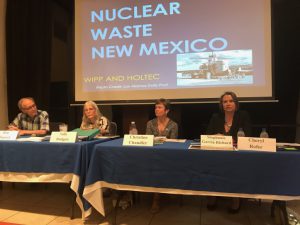
BY MAIRE O’NEILL
maire@losalamosreporter.com
Multiple concerns were raised by panel members Wednesday June 21, 2019 during a forum on nuclear waste in the state of New Mexico hosted by the Santa Fe Democratic Party Platform and Resolutions Committee at the Center for Progress and Justice in Santa Fe.
Land Commissioner Garcia Richard said her office has direct oversight of mineral leasing at the proposed Holtec site. She made public a letter she sent to the Nuclear Regulatory Commission expressing her concerns about representations made by Holtec to the NRC and New Mexicans about its control of the proposed site as well as agreements it claims to have secured from the state Land Office. She said while the Eddy-Leah County Energy Alliance LLC privately owns the surface of the proposed site, the State Land Office owns the mineral estate and that has not been disclosed by Holtec.
Moderator for the event was Cheryl Rofer, a chemist who retired in 2001 from Los Alamos National Laboratory following a 35-year career in which she worked on projects dealing with environmental cleanup at Los Alamos and in Estonia and Kazakhstan; disassembly and decommissioning of nuclear weapons; and chemical weapons destruction.
Rofer gave an overviews of the Waste Isolation Pilot Project (WIPP) near Carlsbad and the proposed Holtec high-level interim disposal site near Eunice. She said WIPP has been operating since 1999 with a hiatus from 2014 through 2016 forced by a burst drum improperly packed at Los Alamos. She said WIPP receives transuranic waste from nuclear weapons production operations.
“Transuranic means waste contaminated with waste beyond uranium on the periodic chart, mainly plutonium, neptunium and americium. Such waste includes gloves, tools, clothing or soil that have been contaminated. The waste currently being sent to WIPP is not considered high-level waste,” she said. “WIPP receives waste from Los Alamos, Hanford, Savannah River, Oak Ridge and Idaho National Laboratory. Recently shipments have increased because WIPP is the only operational nuclear waste repository in the entire country and holders of other types of waste are looking at it as a destination.”
